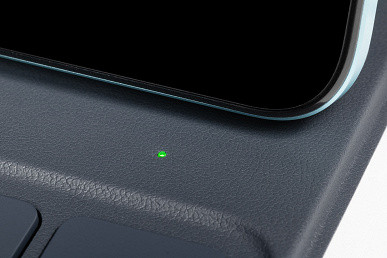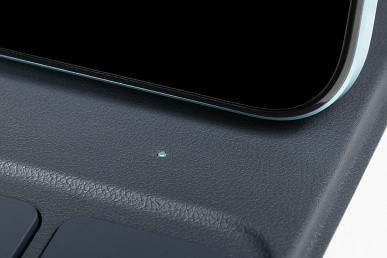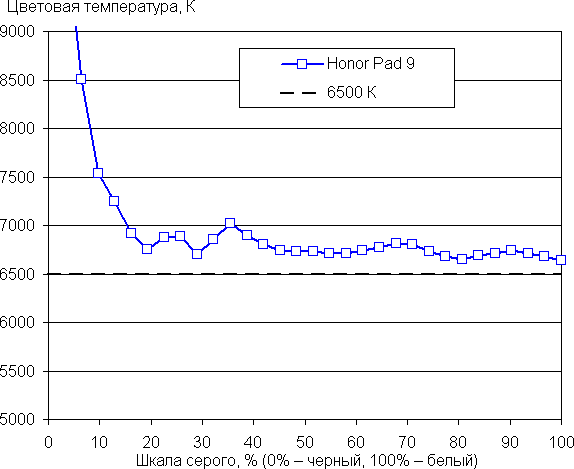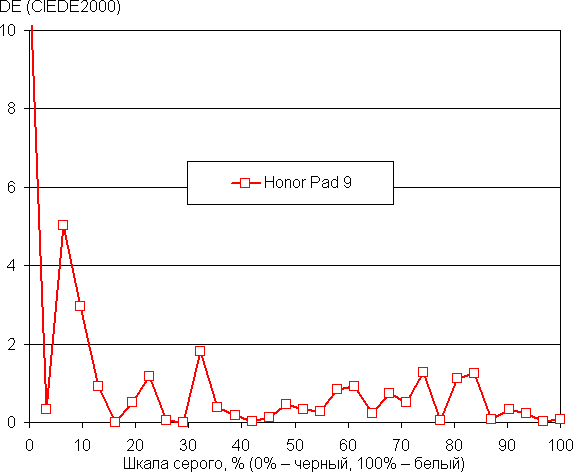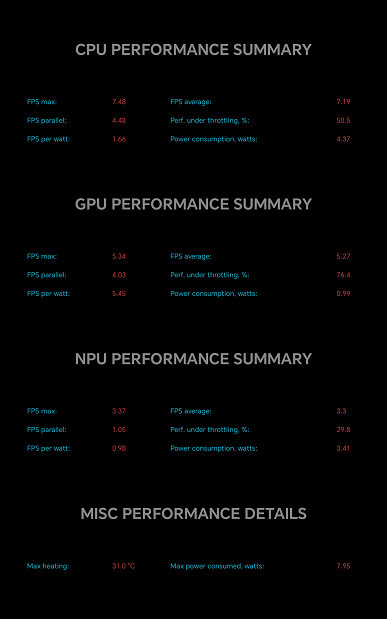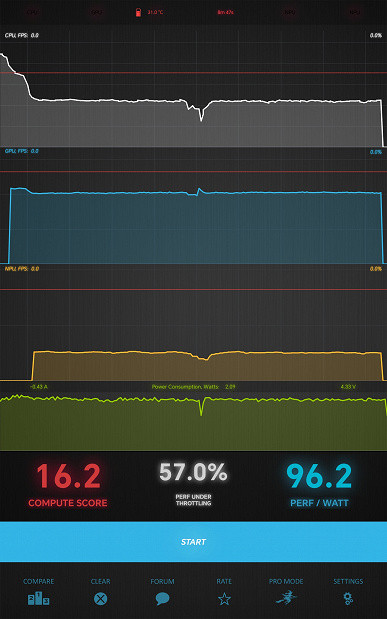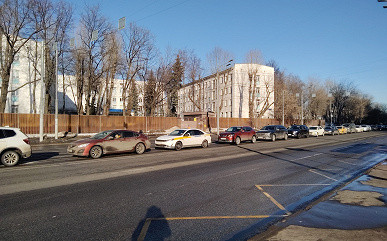Tablets with screens larger than 12 inches occupy a small but significant share of the market, targeting mainly professional use and attempting to partially replace ultraportable laptops. Choices in this segment are limited and new options are welcome. Today we will test one of them — Honor Pad 9.
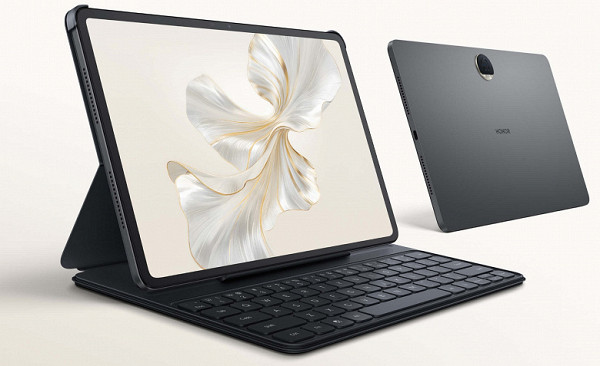
The tablet is available in configurations with internal storage of 128 or 256 GB. At the moment, this is one of the most affordable devices with a screen size larger than 12 inches. Tablets from other manufacturers with similar screens tend to be higher-end and significantly more expensive (the 12.9-inch iPad Pro isn't even included in the table, as it costs five times more).
| Honor Pad 9 | Honor Pad X9 LTE | Huawei MatePad 11.5″ (2023) | Huawei MatePad Pro 13.2″ | |
|---|---|---|---|---|
| Screen | IPS, 12.1″, 2560×1600 (249 ppi) with a refresh rate of 120 Hz | IPS, 11.5″, 2000×1200 (203 ppi) with a refresh rate of 120 Hz | IPS, 11.5″, 2200×1440 (229 ppi) with a refresh rate of 120 Hz | flexible OLED, 13.2″, 2880×1920 (262 ppi) |
| SoC (processor) | Qualcomm Snapdragon 6 Gen1 (8 cores, 4+4, maximum frequency 2.2 GHz) | Qualcomm Snapdragon 685 (8 cores, 4+4, maximum frequency 2.8 GHz) | Qualcomm Snapdragon 7 Gen1 (8 cores, 1+3+4, maximum frequency 2.40 GHz) | Kirin 9000W (8 cores, 1+3+4, maximum frequency 3.13 GHz) |
| RAM (GB) | 8 | 4 | 6 / 8 | 12 |
| Flash memory (GB) | 128/256 | 128 | 128 | 256/512 |
| Memory card support | No | No | No | No |
| Connectors | USB 3.0 (USB-C connector) with support for external storage devices | USB 3.0 (USB-C connector) with support for external storage devices | USB 3.2 Gen1 (USB-C connector) with external storage support | USB 3.2 Gen1 (USB-C connector), keyboard connector |
| Cameras | front (8 MP, video 1080p 30 fps) and rear (13 MP, video 4K 30 fps) | front (5 MP, video 1080p 30 fps) and rear (5 MP, video 1080p 30 fps) | front (8 MP, video 1080p) and rear (13 MP, video 4K 30 fps) | front (16 MP, video 1080p 30 fps) and rear (13 MP and 8 MP, video 4K 30 fps) |
| Internet | Wi-Fi 5 (802.11ac, 2.4/5 GHz) | Wi-Fi 5 (802.11ac, 2.4/5 GHz) | Wi-Fi 6 (802.11ax, MIMO, 2.4/5 GHz), LTE (optional) | Wi-Fi 6 (802.11ax, MIMO, 2.4/5 GHz) |
| Authorization | face recognition | face recognition | face recognition | face recognition |
| Keyboard/stylus cover support | is/is | is/is | is/is | is/is |
| operating system | Android 13 with MagicOS 7.2 shell | Android 13 with MagicOS 7.1 shell | Huawei HarmonyOS 3.1 | Huawei HarmonyOS 4 |
| Battery | 8300 mAh | 7250 mAh | 7700 mAh | 39 Wh |
| Dimensions | 278×180×7.0 mm | 267×167×6.9 mm | 261×177×6.9 mm | 289×196×5.5 mm |
| Weight of version without LTE | 555 g | 499 g | 499 g | 580 g |
Packaging and equipment
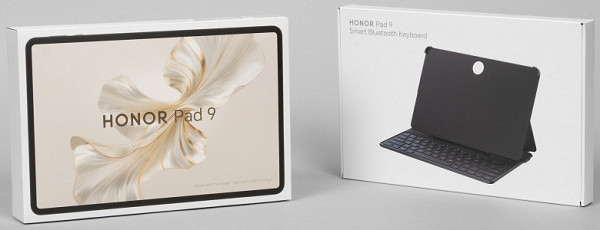
Packaging and equipment
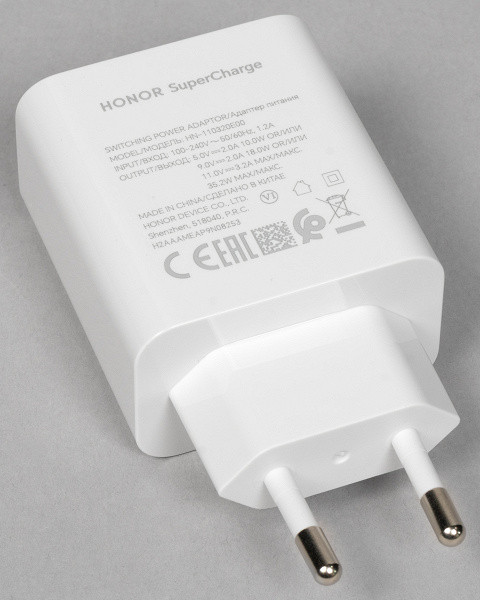
Inside the main package you will only find a charger, a USB-A to USB-C cable (for charging) and a quick start guide. However, it is worth noting that the charger supports Honor SuperCharge technology, unlike the one that comes with the Honor Pad X9. Its maximum power is 11 V 3.2 A. These are very impressive characteristics!
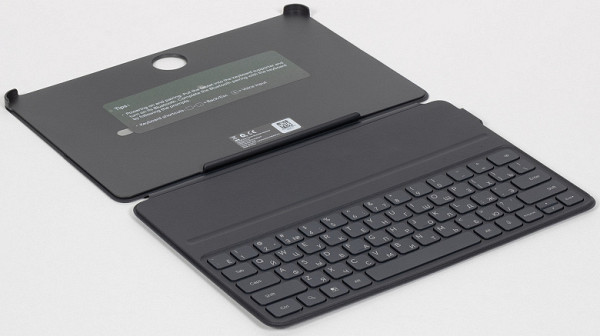
Now let's look at the keyboard cover. At first glance, it seems that its upper part is detached from the lower, but in fact this is not the case.
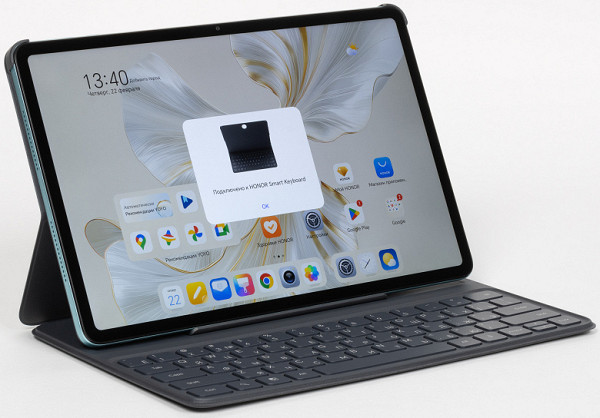
The tablet is inserted between the protruding “ears” of the cover, and in typing mode the entire structure looks like this (picture above)
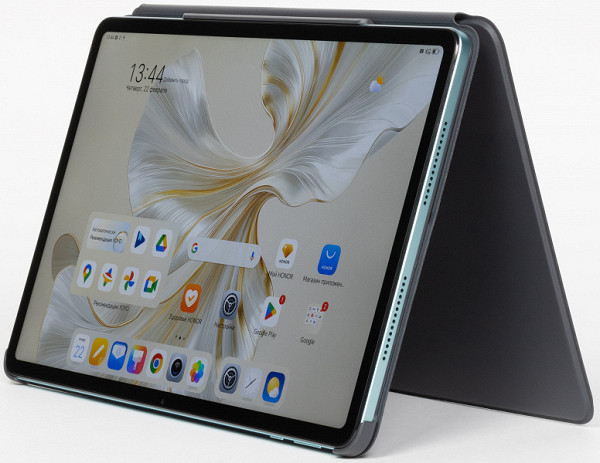
You can simply install the tablet vertically, which will be convenient for reading.
The lack of physical keyboard connectors on the tablet means that the Smart Bluetooth Keyboard connects via Bluetooth. After the initial connection, this process will be carried out automatically.
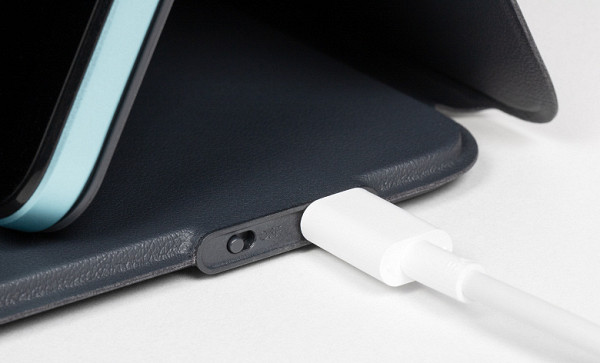
To charge the accessory, use the USB-C port located to the right of the keyboard part. There is also a small switch that allows you to turn off the Smart Bluetooth Keyboard to avoid unnecessary battery drain when idle. The device's on/off status is indicated by an LED above the Backspace key.
The keyboard keys have sufficient height (for accessories of this type) and good elasticity. They are securely fixed, providing a pleasant and elastic press. Thanks to the sufficiently sized keys, it is convenient to type even touch-sensitively.
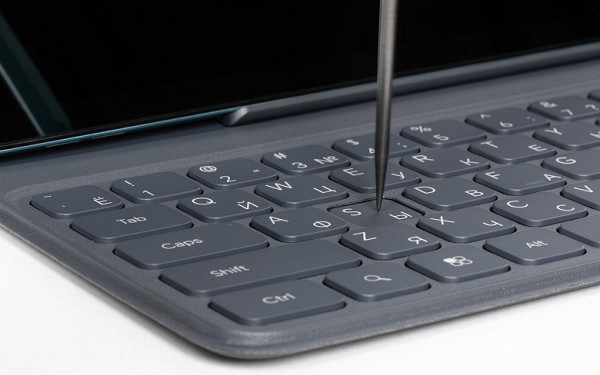
Perhaps the main drawback of the keyboard case is the lack of a magnetic seal when closed. That is, it remains free, not fixed, and even when completely closed, the screen does not turn off if it was turned on. But overall the impressions from this accessory are very positive. Its main advantage is reliable protection of the device from all sides and ease of use, especially when the tablet is held on the lap.
Design
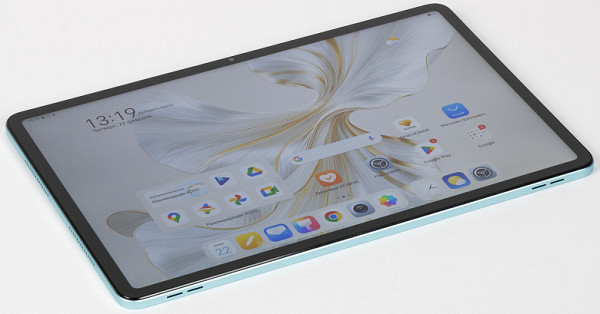
The front panel is almost completely covered by the display. The width of the frame (non-working area) around the screen is approximately 8 mm at all edges. This is comparable to the Honor Pad X9, but the total screen area is larger, which means a higher percentage of usable surface area.
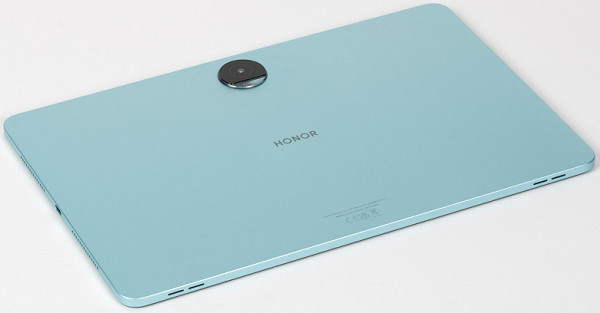
The front panel is almost completely covered by the display. The width of the frame (non-working area) around the screen is approximately 8 mm at all edges. This is comparable to the Honor Pad X9, but the total screen area is larger, which means a higher percentage of usable surface area.
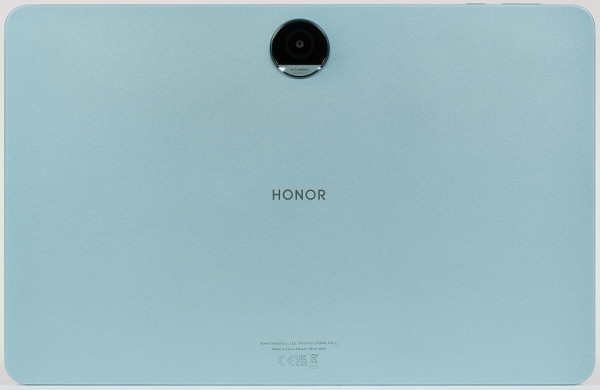
The color of the device is a fascinating palette. It may appear minty in photos, but in reality the shade is more exciting: in certain lighting and viewing angles, it takes on a silvery, metallic hue. While when the light changes or the device is rotated, a true light green-bluish tone appears. This effect gives the device a beautiful and unique appearance.

The side edges of the device are represented by flat surfaces with slight curves at the transitions to the front and rear panels. The control buttons (volume and power) are located on the top/right side of the side and are made of metal, which matches the material of the case. Microphone holes are also located next to them.

The speaker holes are located on the narrow side edges. They provide decent (by the standards of the form factor) stereo sound with pronounced positioning.

Similar to the Honor Pad X9, dynamic holes are located not only on the sides, but also on the bottom edge of the device. This allows sound to spread not only right/left, but also downwards when gaming, listening to music or watching videos, creating a more spacious sound experience.
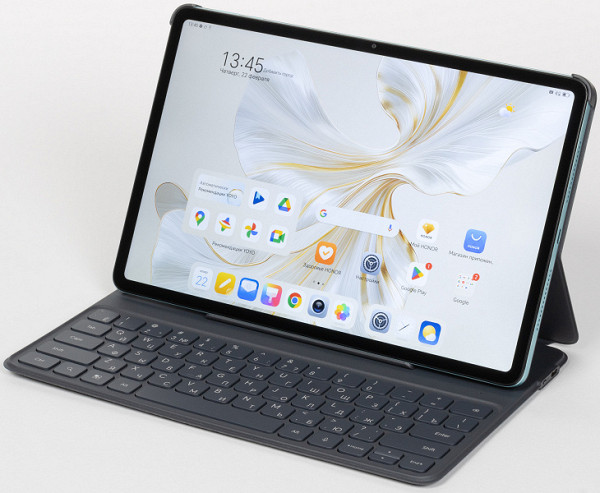
The only interface connector is USB-C with support for connecting external drives. It operates in USB 3.0 mode, providing high speed data transfer between the device and the flash drive. Unfortunately, the tablet cannot accommodate SIM cards or memory cards; There are no removable trays or plastic “radio gaps” in the housing for the internal antenna.
Overall, the design deserves high praise thanks to its unusual delicate color, thin metal body, narrow bezel around the display and the presence of eight speakers with full stereo sound positioning.
Screen
The tablet screen has a diagonal of 12.1 inches and a resolution of 2560x1600, while providing a pixel density of 249 ppi. The screen surface is made of glass with a mirror-smooth surface that is scratch-resistant. The anti-glare properties of the screen are superior to those of the Nexus 7, which ensures good visibility even in intense ambient light. The OGS (One Glass Solution) screen minimizes reflections and improves visual perception. The outer surface of the screen has an oleophobic coating that effectively repels grease and makes it easy to clean from fingerprints.
The maximum screen brightness is 550 cd/m², ensuring excellent readability even in bright sunlight. The minimum brightness value is 2 cd/m², which allows you to comfortably use the tablet in low light conditions. Automatic brightness adjustment based on the light sensor works effectively, adjusting the brightness to changing lighting conditions.
The IPS matrix type provides wide viewing angles and high-quality color display. The screen is devoid of noticeable backlight modulation at any brightness level, which eliminates screen flickering.
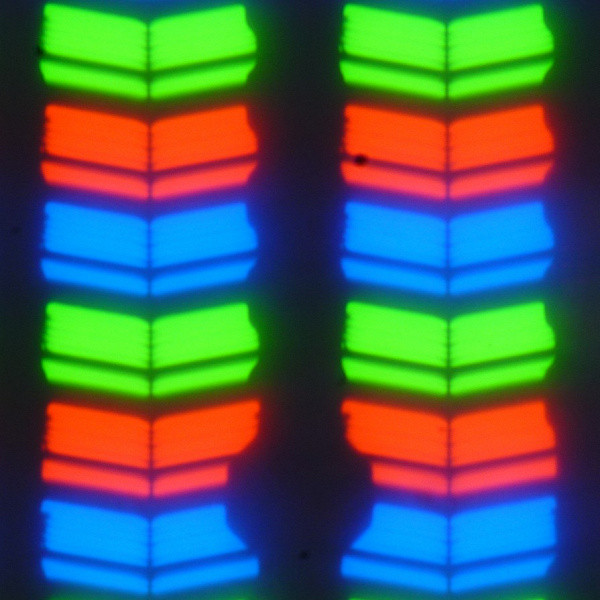
Here are photos in which the screens of this tablet and the Nexus 7 display the same images. The initial brightness of the screens is set to approximately 200 cd/m², and the color balance on the camera is forced to 6500 K.
Image of a white field photographed perpendicular to the screens:
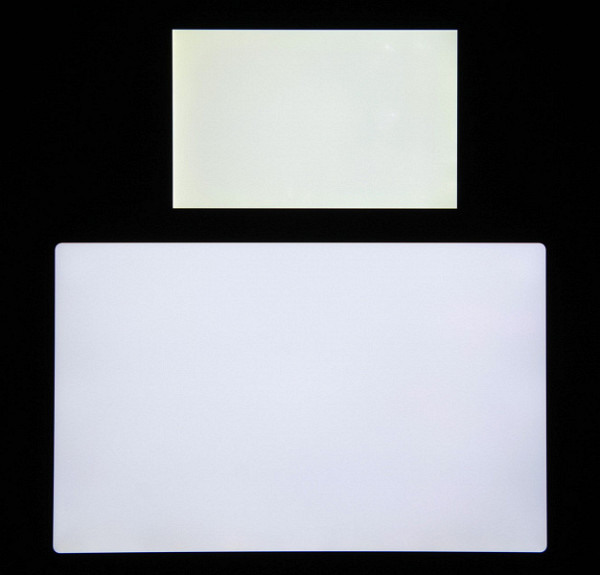
Note the good uniformity of brightness and color tone of the white field.
And a test picture:

The colors on the screen of the tested tablet have a saturation close to natural, and the color balance of the screens clearly differs.
When viewed perpendicularly, the uniformity of the black field is good:
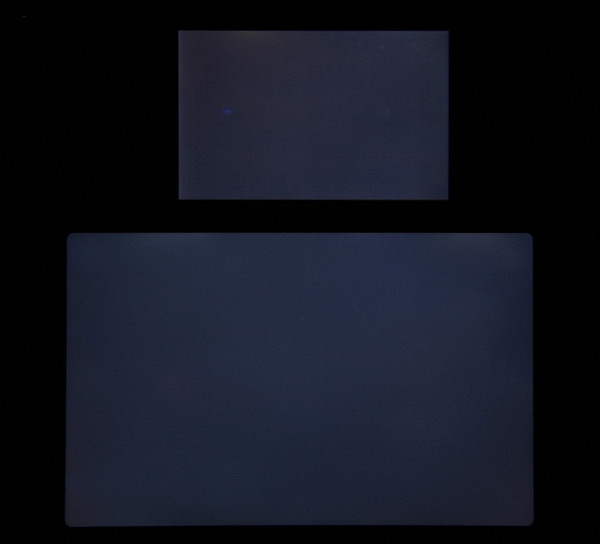
The screen of this tablet has excellent viewing angles, without causing significant color shifts even at large tilt angles relative to the perpendicular to the screen and without inversion of shades. However, when deviated diagonally, the black field becomes brighter and acquires a slight purple tint.
The contrast (approximately in the center of the screen) is high, about 1400:1. The response time from black to white and back is 17 ms (9 ms on + 8 ms off). The transition between halftone grays at 25% and 75% (based on the numerical value of the color) takes a total of 27 ms.
The screen settings provide a mode with an increased refresh rate of up to 120 Hz, which significantly improves the smoothness of scrolling lists and menus.
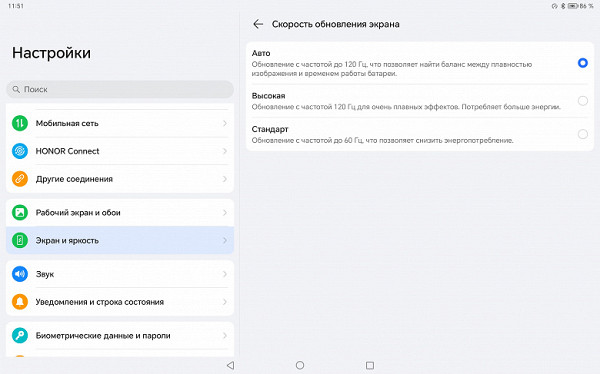
The gamma curve, based on 32 points with equal intervals of numerical gray values, showed no distortion in either light or dark areas. The power function fit exponent is 2.29, which is slightly higher than the standard value of 2.2, resulting in a slightly darker image. At the same time, the real gamma curve deviates little from the standard power-law dependence.
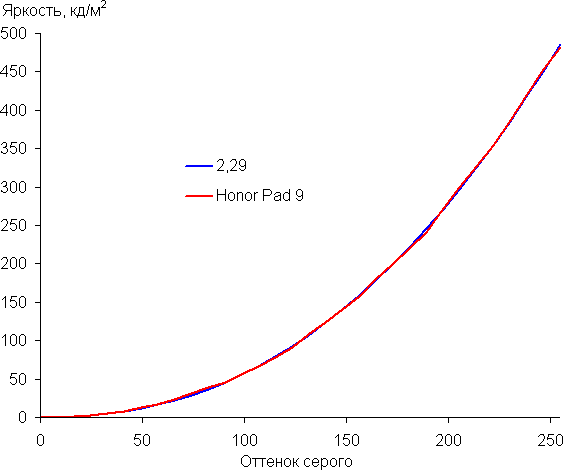
This device implements dynamic adjustment of the backlight brightness depending on the nature of the displayed image. In dark areas in the middle image, the backlight brightness decreases slightly. Because of this feature, the dependence of brightness on hue (gamma curve) does not strictly correspond to the gamma curve of a static image, since the measurements were carried out with sequential output of shades of gray almost over the entire screen. This led to a number of tests, such as contrast and response time, and comparison of black bleed at angles, being carried out using special patterns with a nearly constant average brightness, rather than solid fields across the entire screen. However, given the slight changes in brightness, this feature is not considered a disadvantage.
The screen color gamut is close to sRGB, which ensures natural and accurate color reproduction.
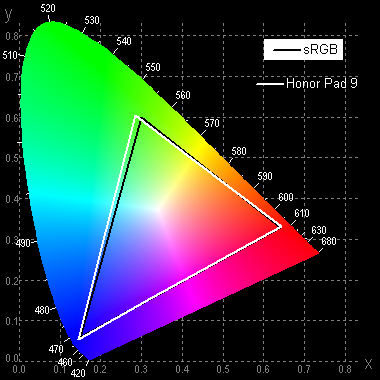
The spectra show that the matrix filters moderately mix the components with each other:
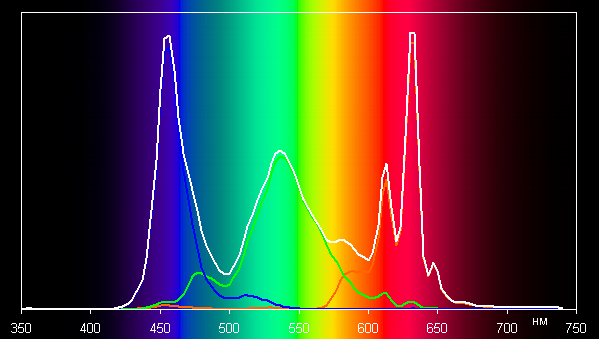
By default, the color temperature on the white field is slightly high, approximately 8900 K. However, this device provides the ability to correct the color balance by adjusting the hue on the color wheel or choosing one of three preset color profiles.
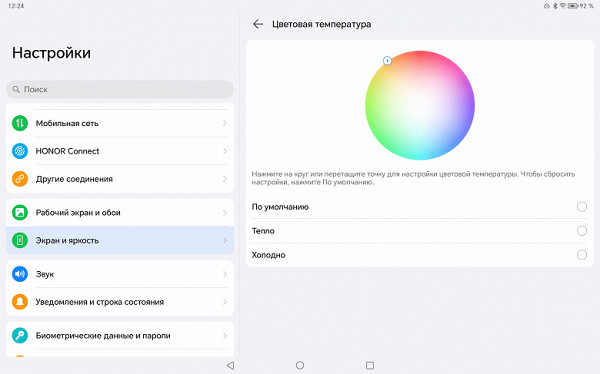
After manual correction (the position of the point is similar to that shown above), it was possible to bring the color temperature closer to the standard 6500 K and maintain a low deviation from the blackbody spectrum (ΔE). At the same time, color temperature and ΔE remain virtually unchanged from shade to shade of gray, which has a beneficial effect on the visual assessment of color balance. (The darkest areas of the gray scale can be ignored, since color balance is not very important there, and the error in measuring color characteristics at low brightness is large.)
However, there is little point in doing this.
There is already a traditional setting that allows you to reduce the intensity of the blue component.

In principle, bright light can disrupt the daily (circadian) rhythm, but this issue is easily resolved by reducing the brightness to a comfortable level, and distorting the color balance by reducing the contribution of blue does not make any sense.
This device probably does not support DisplayPort Alt Mode for USB Type-C, which allows you to output image and sound to an external device when connected to a USB port.
To summarize: The screen has a high maximum brightness (up to 550 cd/m²) and excellent anti-glare properties, which allows you to use the device even outdoors on a bright sunny day. In complete darkness, the brightness can be reduced to a comfortable level (2 cd/m²). It is recommended to use the mode with automatic brightness adjustment, which functions adequately. Among the advantages of the screen, it is worth highlighting an effective oleophobic coating, no air gap between the layers of the screen, no flicker, high contrast (1400:1), a mode with an increased refresh rate of up to 120 Hz, support for the sRGB color space and good color balance after manual correction. Disadvantages include low black stability when viewing angle changes. Considering the importance of characteristics for this class of devices, we can assume that the screen is of high quality.
Performance
Honor Pad 9 is powered by Qualcomm Snapdragon 6 Gen1 processor, featuring four power-efficient cores and four high-performance cores clocked at 2.2 GHz. The test configuration of the device has 8 GB of RAM, with the possibility of “virtual” memory expansion.
Let's compare the performance of the Honor Pad 9 with the Honor Pad X9, which we recently tested. It should be noted that our tests were carried out in the «Performance» mode. However, a comparison of benchmark results in this mode and in the default mode did not show a significant difference. Apparently, the benchmarks still extract the maximum performance of the device.
Let's start with browser tests: Octane Benchmark, Kraken Benchmark and JetStream 2.
| Honor Pad 9 (Qualcomm Snapdragon 6 Gen1) | Honor Pad X9 (Qualcomm Snapdragon 685) | |
|---|---|---|
| Octane 2.0 (points, more is better) | 23442 | 15430 |
| Kraken Benchmark 1.1 (ms, lower is better) | 1864 | 2573 |
| JetStream 2.0 (points, more is better) | 64 | 55 |
It is interesting that, despite the lower frequency of the CPU cores, in browser benchmarks the Honor Pad 9 is significantly ahead of the Honor Pad X9, thanks to more powerful cores.
Next, let's look at the comprehensive benchmark Geekbench 6 (AnTuTu, unfortunately, did not work correctly on the tablet).
| Honor Pad 9 (Qualcomm Snapdragon 6 Gen1) | Honor Pad X9 (Qualcomm Snapdragon 685) | |
|---|---|---|
| Geekbench 6 Single-Core Score (scores, higher is better) | 944 | 478 |
| Geekbench 6 Multi-Core Score (scores, higher is better) | 2764 | 1567 |
Here the situation becomes even more clear: in single-core mode the gap is almost exactly twofold. In multi-core mode, this gap is slightly smaller, but still close to doubling performance.
Let's move on to gaming tests, namely GFXBenchmark. The 3DMark package was installed on the tablet, but none of the subtests could be loaded. Therefore, we limit ourselves to a single tool. We remind you that we are only considering Offscreen tests, where the image is rendered in a fixed resolution.
| Honor Pad 9 (Qualcomm Snapdragon 6 Gen1) | Honor Pad X9 (Qualcomm Snapdragon 685) | |
|---|---|---|
| GFXBenchmark 1440р Aztec Ruins (High Tier Offscreen) | 10 fps | 3 fps |
| GFXBenchmark 1080p Aztec Ruins (Normal Tier Offscreen) | 29 fps | 10 fps |
| GFXBenchmark 1080p Car Chase Offscreen | 24 fps | 8 fps |
| GFXBenchmark 1440p Manhattan 3.1.1 Offscreen | 26 fps | 8 fps |
| GFXBenchmark 1080p Manhattan 3.1 Offscreen | 45 fps | 16 fps |
| GFXBenchmark 1080p Manhattan Offscreen | 63 fps | 23 fps |
As for the CPU, the gap between the two models was approximately two times, but in terms of GPU performance the difference is even more impressive — about three times. This result is impressive!
However, it is worth noting that with prolonged intensive work, a significant decrease in productivity is possible, as much as 57%.
However, in general, we can safely recommend the tablet for all operations with moderate loads, and with some reservations, for games.
Operating system and applications
The Honor Pad 9 tablet uses the Android 13 operating system, on which Honor’s own MagicOS shell is installed, in this case version 7.2. It is important to note that users can take advantage of all Google services, including the ability to install applications from the Play Store (despite possible problems with Russian payment cards, which are independent of Honor).
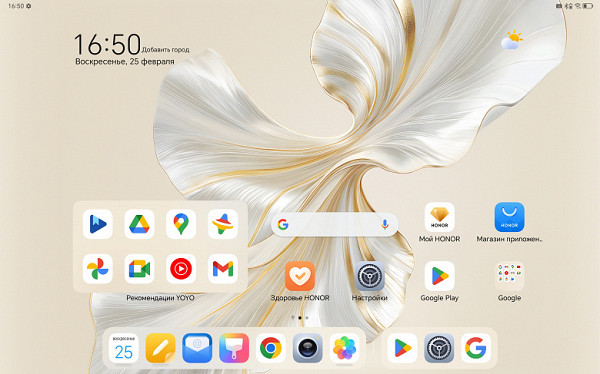
Since there are no significant changes in the software department compared to the Honor Pad X9 we previously tested, we recommend referring to our previous review for more information.
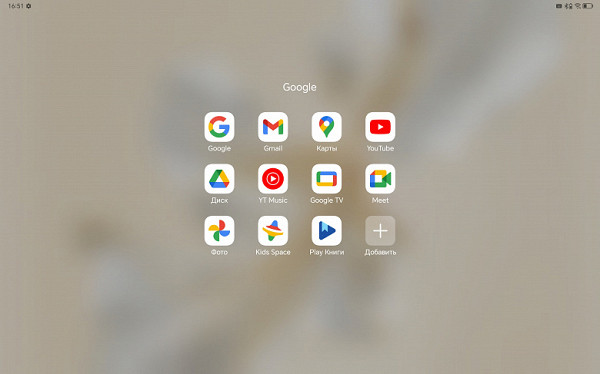
Communication and navigation
Honor Pad 9 lacks a built-in cellular module and satellite navigation, which eliminates the possibility of using the tablet to determine location in the absence of Wi-Fi.
As for Wi-Fi, the device does not support the Wi-Fi 6 (802.11ax) standard, which, of course, is a disadvantage for this device. However, there is support for Wi-Fi 5 (802.11ac), including the 5 GHz band.
Autonomous operation
Honor Pad X9 is equipped with a non-removable battery with a capacity of 8300 mAh. That's more than the Pad X9, but given the significantly larger screen and improved performance, expected battery life results may be less impressive. Let's look at how the device performed in the tests. All tests were carried out at default settings, with the exception of brightness, which was traditionally set at 100 cd/m² (a comfortable level for working in moderately lit rooms).
| Honor Pad 9 (Qualcomm Snapdragon 6 Gen1) | Honor Pad X9 (Qualcomm Snapdragon 685) | |
|---|---|---|
| 3D games, GFXBenchmark T-Rex battery benchmark | 7 hours 56 minutes | — |
| Watching online videos from YouTube | 13 hours 40 minutes | 17 hours 40 minutes |
| Reading mode, white background | 16 hours 35 minutes | 24 hours 40 minutes |
The tablet did demonstrate shorter battery life. However, in 3D gaming mode, the tablet continued to work for almost eight hours, which is a very impressive indicator.
In addition, the device supports fast charging: in just half an hour the charge level increases by 30%, and a full charge takes about two hours, which is a fairly good result for a large device.
Cameras
The Honor Pad 9's single rear camera features a 13-megapixel sensor, which is a significant improvement over previous models. However, the shooting quality remains low, especially during the day, which is typical for tablets that do not pretend to be the main camera.
Photos taken by the Honor Pad 9's rear camera have a noticeable level of noise, low detail, and color variations compared to the actual image seen on the tablet's screen at the time of shooting. The 2x shooting mode, available through the Camera app, features digital zoom rather than optical zoom. Enabling artificial intelligence (AI mode) may slightly improve the clarity of some fine details. Below is an example shot using 2x zoom from the same point where the previous photo was taken.
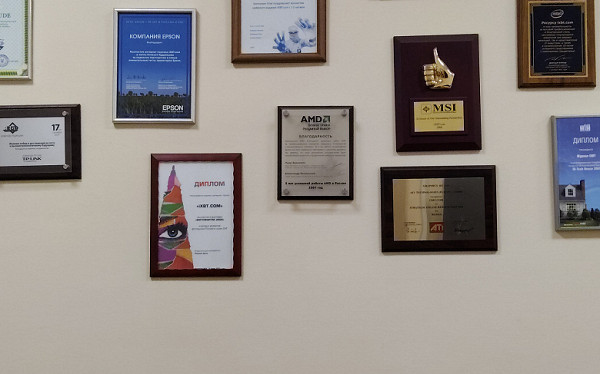
Video recording in 4K resolution at 30 frames per second on the Honor Pad 9 leaves an overall positive impression. However, it is worth noting that the lack of image stabilization makes every slight hand shake noticeable in the video. The example video recorded is 102 MB in size.
The front camera of the device has a resolution of 8 megapixels, which is more than enough for video calls and taking selfies.

In general, the tablet certainly does not claim to be an advanced solution for mobile photography, so the buyer’s expectations should be appropriate.
conclusions
The Honor Pad 9 tablet has several significant advantages: a spacious 12.1-inch screen, a body made of a single piece of metal, a comfortable keyboard cover and, of course, an attractive price. If we take into account the requirement for devices from well-known brands that combine all these qualities, then there is practically no alternative.
It is important to take into account some disadvantages, such as the average level of autonomy (there are tablets with longer battery life), the lack of navigation modules and the lack of support for memory cards. However, for many users these nuances may not be so critical, especially considering the attractive price aspect.
With all this, Honor Pad 9 offers an attractive design, an outstanding IPS screen and mid-class performance levels. Overall, a successful and balanced device.

